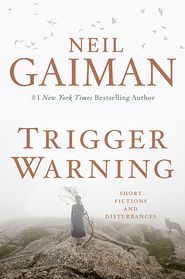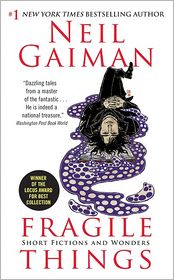6 Neil Gaiman Short Stories to Haunt Your Dreams
Trigger Warning: Short Fictions and Disturbances
Trigger Warning: Short Fictions and Disturbances
By Neil Gaiman
Hardcover $26.99
The release of a new Neil Gaiman novel is a seismic event, but with today’s release of Trigger Warning, his latest compilation of short fiction, we’ve been given another reminder that he is the owner and operator of a veritable short-story factory. Like its predecessors, Smoke and Mirrors and Fragile Things, Trigger Warning is filled to the brim with teeny-tiny disturbances and slim, sly emotional wallops. There are quaint nuggets like “Making a Chair,” relatable to anyone who’s wandered bleary-eyed through an IKEA, and there are stories that go bump in the night, like “Click-Clack the Rattlebag.” There are the experimental narratives (“A Calendar of Tales”), and there are the new spins on old favorites (“The Sleeper and The Spindle”).
It’s a veritable buffet of sweetly sinister fiction. Of course, that shouldn’t be a surprise: These stories join a long list of unforgettable briefs from the mind of a master. To commemorate the new book, here are a few of my favorite Gaiman short stories (just a few, mind you—there are so many more to relish).
The release of a new Neil Gaiman novel is a seismic event, but with today’s release of Trigger Warning, his latest compilation of short fiction, we’ve been given another reminder that he is the owner and operator of a veritable short-story factory. Like its predecessors, Smoke and Mirrors and Fragile Things, Trigger Warning is filled to the brim with teeny-tiny disturbances and slim, sly emotional wallops. There are quaint nuggets like “Making a Chair,” relatable to anyone who’s wandered bleary-eyed through an IKEA, and there are stories that go bump in the night, like “Click-Clack the Rattlebag.” There are the experimental narratives (“A Calendar of Tales”), and there are the new spins on old favorites (“The Sleeper and The Spindle”).
It’s a veritable buffet of sweetly sinister fiction. Of course, that shouldn’t be a surprise: These stories join a long list of unforgettable briefs from the mind of a master. To commemorate the new book, here are a few of my favorite Gaiman short stories (just a few, mind you—there are so many more to relish).
Fragile Things: Short Fictions and Wonders
Fragile Things: Short Fictions and Wonders
By Neil Gaiman
In Stock Online
Paperback $7.99
“Chivalry”
I have adored this particular gem from Smoke and Mirrors since the first time I read its opening line: “Mrs. Whitaker found the Holy Grail; it was under a fur coat.” It’s easy to dwell on Gaiman’s love of the dark; his spookiness is what usually springs to mind when thinking of the creative force behind Sandman and Coraline. But he can be equal parts light and dark, and “Chivalry” is as pleasant a romp as you can imagine. On a routine trip to a secondhand shop, Mrs. Whitaker buys a dusty silver goblet for 50 pence. She goes home. She has a practical dinner. And then a visitor straight out of the pages of Chivalry 101 shows up on her doorstep. It’s got that signature blend of real-life and fantasy that Gaiman so reliably delivers.
“October in the Chair”
This story, found in Fragile Things, is the equivalent of drinking a hot cider on a chill autumn evening, reading like a dry run for The Graveyard Book (“children in cemeteries” has got to be at least two shots in the Neil Gaiman Drinking Game.) A young runaway communing with the dearly departed is merely the story inside the story, here being told by the embodiment of October at a regularly scheduled meeting of the months, which turns into a pretty nifty exercise in personification.
“Chivalry”
I have adored this particular gem from Smoke and Mirrors since the first time I read its opening line: “Mrs. Whitaker found the Holy Grail; it was under a fur coat.” It’s easy to dwell on Gaiman’s love of the dark; his spookiness is what usually springs to mind when thinking of the creative force behind Sandman and Coraline. But he can be equal parts light and dark, and “Chivalry” is as pleasant a romp as you can imagine. On a routine trip to a secondhand shop, Mrs. Whitaker buys a dusty silver goblet for 50 pence. She goes home. She has a practical dinner. And then a visitor straight out of the pages of Chivalry 101 shows up on her doorstep. It’s got that signature blend of real-life and fantasy that Gaiman so reliably delivers.
“October in the Chair”
This story, found in Fragile Things, is the equivalent of drinking a hot cider on a chill autumn evening, reading like a dry run for The Graveyard Book (“children in cemeteries” has got to be at least two shots in the Neil Gaiman Drinking Game.) A young runaway communing with the dearly departed is merely the story inside the story, here being told by the embodiment of October at a regularly scheduled meeting of the months, which turns into a pretty nifty exercise in personification.
Smoke and Mirrors: Short Fictions and Illusions
Smoke and Mirrors: Short Fictions and Illusions
By Neil Gaiman
In Stock Online
Paperback $15.99
“Troll Bridge”
Oh, it’s just your typical boy-meets-troll story. Or, more accurately, it’s boy meets naked, mostly translucent troll: “He was all my nightmares given flesh.” A recurrent motif in Gaiman’s works is the longing look back at childhood (a theme rather poignantly explored in The Ocean at the End of the Lane). In this Smoke and Mirrors entry, it’s a creepy-crawly sort of nostalgia, which can be equally satisfying. A boy meets a troll under a bridge. The troll threatens to eat his life. The boy slyly wriggles away by saying he’ll taste better when he’s lived more fully. And thus we watch the boy age, until finally it’s time to meet the troll again.
“A Study in Emerald”
Any piece of Sherlock Holmes fiction that gets its author inducted into the Baker Street Irregulars has to be fairly impressive. That this one is a pastiche of H.P. Lovecraft’s Cthulhu mythos and “A Study in Scarlet” is all the more daring. (You have definitely never seen Queen Victoria in such a state.) Presented here is a younger and livelier Holmes than we find in “The Case of Death and Honey” from Trigger Warning, but both are sure to warm the cockles of even the most curmudgeonly, canonical heart.
“Foreign Parts”
You know those days you wake up and you’re not sure your penis belongs to you anymore? I hate those days.
“Troll Bridge”
Oh, it’s just your typical boy-meets-troll story. Or, more accurately, it’s boy meets naked, mostly translucent troll: “He was all my nightmares given flesh.” A recurrent motif in Gaiman’s works is the longing look back at childhood (a theme rather poignantly explored in The Ocean at the End of the Lane). In this Smoke and Mirrors entry, it’s a creepy-crawly sort of nostalgia, which can be equally satisfying. A boy meets a troll under a bridge. The troll threatens to eat his life. The boy slyly wriggles away by saying he’ll taste better when he’s lived more fully. And thus we watch the boy age, until finally it’s time to meet the troll again.
“A Study in Emerald”
Any piece of Sherlock Holmes fiction that gets its author inducted into the Baker Street Irregulars has to be fairly impressive. That this one is a pastiche of H.P. Lovecraft’s Cthulhu mythos and “A Study in Scarlet” is all the more daring. (You have definitely never seen Queen Victoria in such a state.) Presented here is a younger and livelier Holmes than we find in “The Case of Death and Honey” from Trigger Warning, but both are sure to warm the cockles of even the most curmudgeonly, canonical heart.
“Foreign Parts”
You know those days you wake up and you’re not sure your penis belongs to you anymore? I hate those days.
The Facts in the Case of the Departure of Miss Finch
The Facts in the Case of the Departure of Miss Finch
By
Neil Gaiman
Illustrator
Michael Zulli
Hardcover $13.95
“The Facts in the Case of the Departure of Miss Finch”
A story so nice it got its own illustrated book. Another of Gaiman’s patented tricks is to write from the perspective of an unnamed narrator, who, you think, sounds an awful lot like Neil Gaiman. So you feel like you know the narrator, because you feel like you know Neil Gaiman; conversely, you think you know Neil Gaiman because he keeps guiding you through all these short stories. It’s an intimate arrangement. And here it’s flawless as an ex-pat Brit tells of coming back to London to write in pseudo-secrecy. Two of his friends, however, invite him to check out a mysterious circus, along with their grumpy fourth wheel: Miss Finch. As is a circus’s way, things go a bit astray and Miss Finch ends up departing. Where to is a mystery worth finding out.
Want more Gaiman in your life? We’ve ranked all of his fiction books, from good to best, here.
“The Facts in the Case of the Departure of Miss Finch”
A story so nice it got its own illustrated book. Another of Gaiman’s patented tricks is to write from the perspective of an unnamed narrator, who, you think, sounds an awful lot like Neil Gaiman. So you feel like you know the narrator, because you feel like you know Neil Gaiman; conversely, you think you know Neil Gaiman because he keeps guiding you through all these short stories. It’s an intimate arrangement. And here it’s flawless as an ex-pat Brit tells of coming back to London to write in pseudo-secrecy. Two of his friends, however, invite him to check out a mysterious circus, along with their grumpy fourth wheel: Miss Finch. As is a circus’s way, things go a bit astray and Miss Finch ends up departing. Where to is a mystery worth finding out.
Want more Gaiman in your life? We’ve ranked all of his fiction books, from good to best, here.



